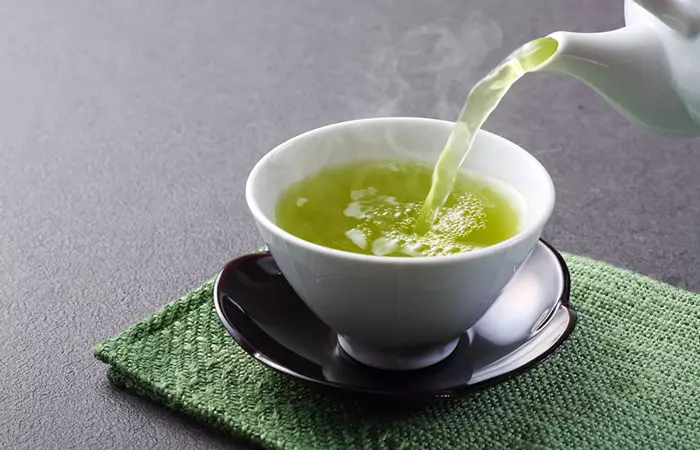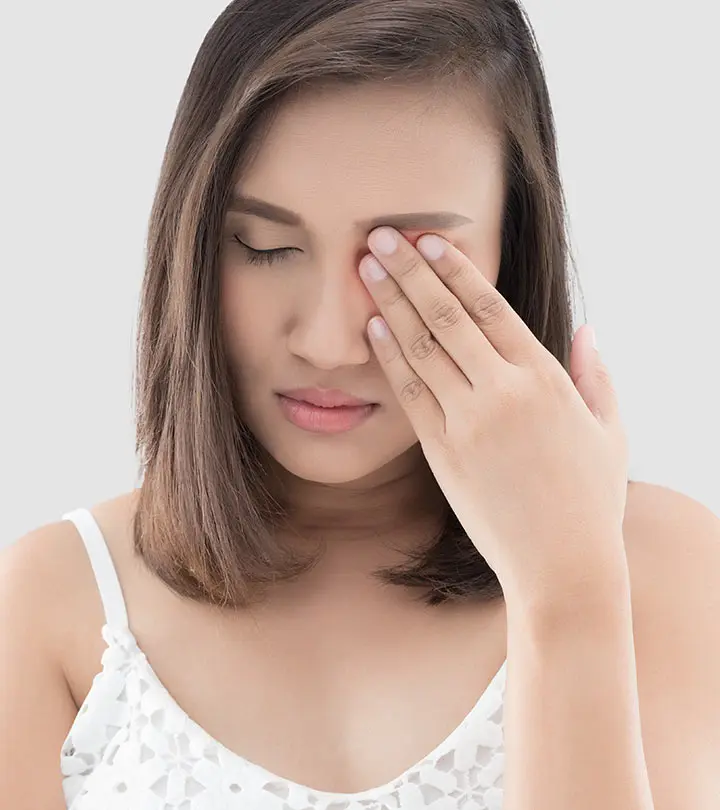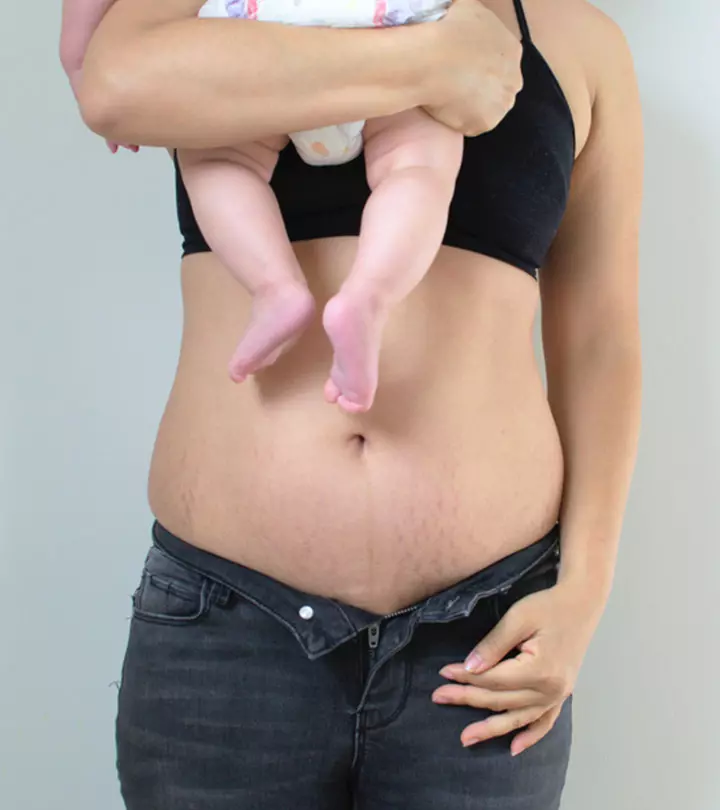24 Effective Home Remedies For Skin Infection
Soothe the pain and swelling on your skin with nourishing ingredients from your pantry.

Image: ShutterStock
How do you treat a skin infection naturally? What are the best home remedies for skin infections? Let’s see what we can find out!
The skin is the first line of defense against viruses, germs, and fungi. And if it becomes infected, you are in grave danger. While serious infections require medical assistance, minor skin infections can be prevented or treated at home. No, you do not need to be a dermatologist to accomplish it. There are several simple home remedies for skin infections that work as an alternative to treat skin issues. Although you should always consult a dermatologist before using any home treatment, you can try these for immediate relief.
Before we go into the list of home remedies for skin infections, let’s define what a skin infection is and the various types of skin infections. Scroll down for more information.
In This Article
What Is Skin Infection?
You get a skin infection when a bacterium, a parasite, a virus or a fungus enters your skin through a cut or an open wound and spreads.
This causes pain, swelling, redness, changes in your skin color, and other symptoms. Skin infection should not be confused with skin rashes. You get rashes when your skin is irritated (by any external agent, including chemicals). Skin infection and skin rashes may have similar symptoms like swelling, redness, and pain. You may get a skin rash because of an infection, but not every skin rash is an infection. You need a proper, holistic diagnosis to determine that. Skin infections can be of many types. Let’s explore them in the next section.
Key Takeaways
- Microbes like bacteria and viruses can infect open wounds and cause skin infections.
- Natural ingredients like yogurt, aloe vera, and honey may soothe minor skin infections.
- The antimicrobial and anti-inflammatory nature of coconut oil and tea tree oil may help treat the infection faster.
- Proper personal hygiene and maintaining distance from an infected person can prevent the spread of contagious skin infections like chicken pox.
Types Of Skin Infection

Skin infections are classified into the following types based on the causes:
1. Fungal Infections
Fungi love the warm and damp folds and areas in your body, especially your armpits, the areas behind your knees, and your feet. Fungal infections are pretty common and usually not contagious. Some common types of a fungal infection include:
- Ringworm
- Yeast infection
- Diaper rash
- Athlete’s foot
2. Bacterial Infections
You might have noticed small red bumps on your face, neck, back, or hands. Often, these red bumps increase in size and are filled with pus due to bacterial invasion. Some common types include:
- Boils
- Cellulitis
- Impetigoi A contagious skin infection found in children, causing red sores around the nose, mouth, and limbs, which burst and form crusts in a week.
- Carbunclesi An infection deep beneath the skin, usually involving multiple hair follicles, causing a lump with pus.
Sarah, a YouTuber, recounts her personal experience with bacterial infections and how it affected her skin and overall appearance. She states, “Ever since I was in high school I have had pimples, whether it was worse or better, I have always had them (i).” She further shares, “I had these red pimples that would stay for a lot of days, some would even stay for like two weeks.”
3. Parasitic Infections
Parasitic infections are not life-threatening but can be uncomfortable. They are usually not localized to the skin and might spread to your bloodstream and organs. Common examples include:
- Scabies
- Lice
- Bedbugs
4. Viral Infections
Viruses can give you mild to significant skin infections. Common viral infections include:
- Measles
- Chickenpox
- Shingles
- Warts
According to a survey of European long-term care facilities (LTCF) that was undertaken between 2016 and 2017 and published in the Journal of Antimicrobial Chemotherapy, the prevalence of healthcare-associated infections (HCAI) is 3.7% or around 4.4 million cases. The most frequent types of HCAI in LTCF were respiratory tract infections (33.2%), UTIs (32.0%), and skin infections (21.5%).
Now, the question is, how do you know if you have a particular skin infection? Simple. You have to check for the symptoms.
Symptoms Of Skin Infection
A tattoo, a piercing, a cut, or a bruise – germs are always looking for openings to invade and infect your skin. While some infections occur on the surface of the skin, some may go beyond that and cause serious issues. Here are a few symptoms you should watch out for:
- Pus or fluid leaking from an open wound
- A reddish bump or a pimple (with or without) a yellow pus-filled crust
- The reddish hue of the skin around the wound
- Sores that appear more like blisters
- Swelling around a bump or wound that gets worse with time
- An open wound that is not healing even after 10 days
- An injury accompanied by a fever
Consult your doctor immediately to identify what is causing the infection. It’s important to know that as that will determine the course of treatment:
What Causes Skin Infection?
Whether it is a fungus, bacteria, virus, parasite or bug bite – anything can cause a skin infection. The causes depend mostly on the type of infection you have. Here are a few factors that might cause a skin infection:
1. Bacteria
Open wounds, cuts, and sores are perfect gateways for bacteria to enter your body. A cut or a bruise always doesn’t mean you will get an infection, but it makes your body more vulnerable to bacterial attacks.
2. Viruses
These are the most common factors that cause an infection. Why? Viral infections are highly contagious. The most common viruses that cause skin infections are herpesvirusi A virus with DNA as its genetic material with Types 1 and 2 which cause cold sores and genital sores, respectively. , poxvirus, and human papillomavirus (this causes skin warts).
3. Fungi
Fungal infections depend a lot on your lifestyle (and cleanliness, of course!) Wearing sweaty clothes for long and not cleaning the folds of your body properly make you vulnerable to fungal infections.
4. Parasites
These are tiny bugs that burrow themselves deep into your skin, laying eggs on your skin and feeding on you (for instance, lice).
 Quick Tip
Quick TipWhile you may treat these issues with over-the-counter, homeopathic, and herbal medications, you can also treat them with simple home remedies. Wondering how? Read on!
How To Diagnose A Skin Infection?
For initial diagnosis, you may check the common symptoms caused by different skin infections. However, a doctor is the best person to run a thorough diagnosis and determine what type of skin infection you have. The doctor can identify the type of infection by checking the appearance of the area where you got it. However, they may also do some more tests for a better diagnosis. The tests may include examining the skin sample and taking a closer look at the lesion.
If the infection is severe, the doctor will suggest antibiotics and other topical medicines (spray, ointments, and salve). However, if you have a minor infection, you can try treating it with home remedies.
Home Remedies For Skin Infection
There are several home remedies that can help ease skin infection symptoms and support healing. While these methods may offer relief, it is important to remember they are not a replacement for medical treatment. If you have a serious infection, it is best to consult with a doctor for proper care and guidance. However, if you have mild skin irritation, you may try the following home remedies for temporary relief.

1. Yogurt
You Will Need
- Unsweetened yogurt
- Cotton pad
What You Have To Do
- Soak the cotton pad in unsweetened yogurt and apply it to the fungal infection.
- Leave it on for 30 minutes and then wash with cold water.
How Often You Need To Do This
Twice a day until the infection is gone.
Why This Works
Plain yogurt contains probiotics that help prevent microbial infections by producing lactic acid
(1).
2. Garlic
You Will Need
- 2 garlic cloves
- 2 drops of olive oil
What You Have To Do
- Mince the garlic cloves and mix with olive oil.
- Apply the paste on the affected area and leave it on for 30 minutes.
- Wash it with lukewarm water.
How Often You Need To Do This
Twice a day.
Why This Works
Garlic has diallyl sulfide and diallyl disulfide that help manage fungal infections
(2).
3. Turmeric

You Will Need
- 1 tablespoon turmeric powder
- 1 teaspoon honey
What You Have To Do
- Mix both the ingredients and make a paste.
- Apply it to the affected area and allow it to dry.
- Wash it off with warm water.
How Often You Need To Do This
Twice a day.
Why This Works
Turmeric contains curcumin that has antibacterial, antiviral, and antifungal properties, which help heal infections
(3).
 Trivia
Trivia4. Aloe Vera
You Will Need
Pure aloe vera gel
What You Have To Do
- Apply the aloe vera gel on the affected area.
- Leave it on for some time and then wash with cold water.
How Often You Need To Do This
Twice or thrice a day.
Why This Works
Aloe vera gel contains anthraquinones, which have antibacterial and antifungal properties (4).
5. Tea Tree Oil
You Will Need
- 1 tablespoon coconut oil
- 2-3 drops of tea tree oil
What You Have To Do
- Mix both the oils and apply the blend to the affected area.
- Leave it on for about half an hour and then wash off.
How Often You Need To Do This
Twice a day.
Why This Works
Tea tree oil has antimicrobial and antifungal properties (5), (6). It can kill a wide range of fungi and bacteria quite efficiently.
6. Honey
You Will Need
- 1 teaspoon honey
- 1 teaspoon onion juice
What You Have To Do
- Combine honey with the onion juice.
- Apply the mixture to the affected area.
- Leave it on for at least 30 minutes and then wash off.
How Often You Need To Do This
Twice a day.
Why This Works
Both onion and honey have antimicrobial properties (7), (8). Honey has been used since ancient times (in traditional medicine) for healing wounds and infections (8). Also, many people use honey for glowing skin too, as its natural properties can help enhance your complexion while providing nourishment and moisture.
7. Ginger
You Will Need
Ginger paste OR a fresh stalk of ginger OR Ginger extracts
What You Have To Do
- Apply raw and fresh ginger paste (or the fresh stalk cut into half or the extract) directly on the affected area.
- Leave it on for 30 minutes and then wash it off.
How Often You Need To Do This
Twice daily.
Why This Works
Ginger has antifungal properties that help inhibit the growth of fungus on the skin (9), (10).
8. Fenugreek
You Will Need
- 1 teaspoon fenugreek seeds
- Cotton pads
- Water
What You Have To Do
- Boil the fenugreek seeds until they become soft.
- Allow the water cool.
- Use cotton pads to apply the liquid to the affected area. Let it dry.
- Wash with cold water.
How Often You Need To Do This
Twice a day.
Why This Works
Fenugreek seeds possess antibacterial properties that inhibit the growth of acne-causing bacteria on the skin (11).
9. Coconut Oil
You Will Need
- 2-3 drops of coconut oil
- 30 mL of olive oil
What You Have To Do
- Mix both the oils and apply the blend to the affected area.
- Leave it on for 30 minutes (or overnight) and wash it off later.
How Often You Need To Do This
Once a day (if you are using it for overnight application) or else twice a day.
Why This Works
Coconut oil contains monolaurin and antibacterial, antifungal, and antiviral agents that help prevent skin infection (12).
10. Baking Soda
You Will Need
- 1/2 teaspoon baking soda
- Water (for making a paste)
What You Have To Do
- Mix the baking soda with water and apply it to the affected area.
- Leave it on for a few minutes (until it dries) and then wash it off.
How Often You Need To Do This
Twice a day.
Why This Works
Baking soda inhibits the growth of bacteria, especially Streptococcus mutans, and other infections that breed in the area around your mouth (13).
11. Olive Oil
You Will Need
- 1 teaspoon olive oil
- 1 teaspoon beeswax
- ½ teaspoon honey
What You Have To Do
- Mix all the ingredients and apply the mixture to the affected area.
- Keep it on for at least 30 minutes and then wash it off.
How Often You Need To Do This
Twice a day.
Why This Works
Olive oil has antibacterial, anti-inflammatory, and antimicrobial properties and is effective against some strains of bacteria (14).
12. Lemon Or Lime Or Any Citrus Fruit
You Will Need
- 1 tablespoon lemon juice (or juice of any citrus fruit such as orange)
- 1 tablespoon olive oil (or any carrier oil)
What You Have To Do
- Mix the lemon juice with olive oil and apply the solution to the affected area.
- Let it sit for 30 minutes.
- Wash it off with water.
How Often You Need To Do This
Once or twice a day until the infection heals.
Why This Works
Lemon juice has antimicrobial and antioxidant properties. Compared to lemon and lime, orange juice has been found to be much stronger against fungal infections (15).
13. Green Tea

You Will Need
- 5-6 green tea bags
- Boiling water
What You Have To Do
- Soak the green tea bags in boiling water.
- Remove the tea bags.
- Apply the water to the affected area. If the infection is on your hands or feet, soak them in this water for at least 10 minutes.
- Wash and wipe clean.
How Often You Need To Do This
Twice a day.
Why This Works
Green tea has antibacterial and anti-inflammatory properties that are effective against skin pathogens (16).
14. Warm Milk
You Will Need
- A glass of warm milk
- 1/2 teaspoon turmeric powder
What You Have To Do
Mix the turmeric powder with warm milk and drink it.
How Often You Need To Do This
Once or twice a day.
Why This Works
Turmeric contains curcumin, which has antibacterial and anti-inflammatory properties (3). Milk contains lactic acid that boosts collagen and makes your skin smooth. The topical application of lactic acid boosts collagen production and makes your skin smooth (17).
15. Cranberry Juice
You Will Need
A glass of cranberry juice (unsweetened)
What You Have To Do
Drink a glass of unsweetened cranberry juice for a month (or until the infection is gone).
How Often You Need To Do This
Once a day.
Why This Works
Cranberry juice was found to be very effective against the bacterium Staphylococcus aureus (18).
16. Margosa Leaves (Neem)
You Will Need
1 tablespoon paste of neem leaves
What You Have To Do
Apply the paste directly on the affected area.
How Often You Need To Do This
Once or twice a day until the infection is healed.
Why This Works
Neem is widely used in Ayurveda and Chinese medicine for its healing and therapeutic properties. It has antioxidant and antibacterial properties that protect your skin from free radical damagei Oxidative damage caused by highly reactive molecules with unpaired electrons to cell components like DNA, proteins, and cell membranes. and inhibit the growth of bacteria (19).
17. Onion Juice
You Will Need
- 1 tablespoon onion juice
- 1 tablespoon betel juice
What You Have To Do
Mix both the juices and apply the mixture on the area that’s infected.
How Often You Need To Do This
Twice a day (until the skin infection has healed).
Why This Works
Onion contains quercetin and thiosulphinate and is exceptionally effective in treating fungal and bacterial infections, including warts (20).
18. Epsom Salt
You Will Need
- ¼ cup Epsom salt
- 500 mL distilled water (warm)
- Gauze
What You Have To Do
- Mix the Epsom salt in distilled water and soak the gauze in it.
- Squeeze out the excess water and place the compress on the infected site for 10 to 15 minutes.
- Repeat the process.
How Often You Need To Do This
Once or twice a day.
Why This Works
Epsom salt does not cure skin infection but helps soften the skin so that the medications that you are using eliminate the infection faster.
19. Tomato
You Will Need
1 tomato
What You Have To Do
1. Blend the tomato to make a paste.
2. Apply it evenly on the affected area.
How Often You Need To Do This
Once a day.
Why This Works
Tomato contains succinic, tartaric, and citric acids that give it antibacterial properties, making it a good remedy to treat skin infections (21).
20. Sea Salt

You Will Need
- 1 cup sea salt
- 1 bucket water
What You Have To Do
- Mix the sea salt in the water and bathe with it.
- You can also add it to your bathtub and soak in it.
How Often You Need To Do This
Once a day.
Why This Works
A study shows that saltwater baths is a preferred therapy for treating infections as salt has antimicrobial properties (22).
21. Thyme
You Will Need
- 2-3 drops thyme essential oil
- 2 tablespoons aloe vera gel
What You Have To Do
- Mix the thyme oil with aloe vera gel.
- Apply the mixture to the affected area and leave it on for 30 minutes.
- Wash with cold water.
How Often You Need To Do This
Once a day.
Why It Works
Thyme contains chemicals that fight bacteria, fungi, and other infections (23).
22. CBD Oil
You Will Need
- ¼ cup CBD oil
- 2 teaspoons coconut oil
What You Have To Do
- Mix the two oils.
- Gently massage the mixture on the affected area.
- Leave it on for 30-60 minutes before washing it off.
How Often You Need To Do This
Once-daily.
Why It Works
Cannabis or CBD oil has therapeutic benefits and is useful in managing acne vulgaris. It also has antibacterial properties and can reduce the growth of bacteria like staphylococci and streptococci that cause skin infections (24), (25).
23. Cucumber
You Will Need
- 1 cucumber
- 1 heat-proof bowl
- 4 cups of water
- 1 teaspoon of rosewater
What You Have To Do
- Slice the cucumber into small pieces and place them in the bowl.
- Add water to the bowl and heat it over a low flame, for 5 minutes.
- Once done, transfer the contents to a blender.
- Blend into a smooth paste and strain it using a fine mesh sieve.
- Pour the liquid into a sterilized container or spray bottle and add a teaspoon of rosewater to the mixture.
- Apply to the affected area and let it sit for 30 minutes before rinsing with cool water.
How Often You Need To Do This
Twice a day
Cucumber calms skin irritation and reduces inflammation. It also helps relieve the discomfort caused by sunburns (26).
24. Hot Compress
You Will Need
- A clean washcloth
- A bowl of warm water
What You Have To Do
- Soak the cloth in warm water and wring out the excess water.
- Place the warm washcloth on the infected area (abscess or boils).
- Hold it in place for a few minutes, remove, and repeat the process.
How Often You Need To Do This
2-3 times a day
Why It Works
A hot compress provides relief from the pain and helps in draining abscesses or boils, thus clearing the infection.
Other than the above-mentioned remedies, you can also try soaking in an oatmeal bath to soothe skin infections. Poultice and colloidal silver dressings also provide relief from skin infection inflammation. Flowers like echinacea, calendula, witch hazel, and chamomile, as well as essential oils like lavender, peppermint, and rosemary, and apple cider vinegar may also help manage symptoms of skin infections.
These home remedies may take several days to show results. However, if you don’t see any signs of healing within a week, consult your doctor.
Most skin infections can be easily treated with medicines and ointments. However, certain strains of bacteria might be tough to treat as they are often resistant to antibiotics. And that’s why you should try prevention measures to avoid contracting a skin infection. Mentioned below are a few tips that will help you do so.
Tips And Precautions For Preventing Skin Infections
Here are some practical precautionary trips that can ensure good health of your skin and keep infections at bay.
- Keep your skin clean and dry, especially in areas where moisture can build up, as damp skin is more susceptible to infections.
- Avoid sharing personal items like towels, razors, or clothing, as this can spread bacteria and fungi.
- Wear breathable clothing made of natural fabrics to help reduce sweat and prevent irritation.
- Wash your hands frequently and do this before touching any wound or applying ointment to it.
- Avoid popping blisters and pimples (sounds tempting, but it’s a strict no-no).
- Cover your mouth and nose. Many infections spread through coughs and sneezes.
- In case you are down with an infection, avoid contact with others. Stay at home and treat it appropriately.
- Make sure you are getting immune-boosting vaccinations for preventing infections and diseases such as measles, chickenpox, shingles, and human papillomavirus.
Infographic: Effective Home Remedies For Skin Infections
Our skin comes in direct contact with a lot of things that may lead to infections. While serious infections require medical attention, minor infections can be managed with some home remedies. We have shortlisted the most effective home remedies in thet the infographic below. Check it out for more details.
Some thing wrong with infographic shortcode. please verify shortcode syntaxSkin infections can develop due to bacteria, fungus, or viruses entering your skin through a cut or wound. It can result in symptoms such as redness, swelling, pus, or fever. You can treat minor skin infections at home with ingredients such as ginger, garlic, tea tree oil, or honey. To reduce the risk of developing skin infections, wash your hands regularly, avoid contact with infected individuals and be up to date with your vaccinations. If your symptoms show no improvement in a week after trying the above home remedies for skin infections, consult your doctor.
Frequently Asked Questions
Can home remedies replace antibiotics?
Home remedies can help reduce symptoms and promote healing but should not replace antibiotics for treating serious infections. Always consult a healthcare provider for proper treatment.
How long does it take for home remedies to work on skin infections?
The time it takes for home remedies to show results can vary depending on the severity of the infection and the remedy used. Generally, you may see improvement within a few days, but persistent issues should be evaluated by a doctor.
Is It possible to fight bacterial skin infection without antibiotics?
There is always a chance that the infection may spread without antibiotics. It is better to consult a doctor for proper treatment.
What is the best antibiotic for skin infection?
Some of the most commonly used and effective antibiotics used for treating skin and soft tissue infections include amoxicillin/clavulanate, ampicillin/sulbactam, piperacillin/tazobactam, cephalexin, cefotaxime, ceftazidime, ofloxacin, ciprofloxacin, levofloxacin, and moxifloxacin (27). You can also use mild antiseptic hydrogen peroxide to treat mild skin infections.
Can a skin infection clear up on its own?
Whether or not a skin infection can clear up on its own depends entirely on the kind of infection it is. Some can clear up on their own, some require topical antibiotic ointments, while others require stronger oral medications and pus drainage.
Illustration: Effective Home Remedies For Skin Infection

Image: Stable Diffusion/StyleCraze Design Team
Try some of these home remedies that truly work against fungal infections in this informative video. These natural solutions will help you combat these common skin ailments. Check it out!
Personal Experience: Source
StyleCraze's articles are interwoven with authentic personal narratives that provide depth and resonance to our content. Below are the sources of the personal accounts referenced in this article.
i. I HAD A BACTERIAL INFECTION | MY SKIN STORY (Sarelly)https://youtu.be/m21eNUn8k1c?feature=shared
References
Articles on StyleCraze are backed by verified information from peer-reviewed and academic research papers, reputed organizations, research institutions, and medical associations to ensure accuracy and relevance. Read our editorial policy to learn more.
- Antimicrobial properties of lactic acid bacteria isolated from traditional yogurt and milk against Shigella strains, GMS hygiene and infection control, US National Library of Medicine, National Institutes of Health.
https://www.ncbi.nlm.nih.gov/pmc/articles/PMC5784316/ - Garlic in dermatology, Dermatology Reports, US National Library of Medicine, National Institutes of Health.
https://www.ncbi.nlm.nih.gov/pmc/articles/PMC4211483/ - A Review on Antibacterial, Antiviral, and Antifungal Activity of Curcumin, BioMed Research International, US National Library of Medicine, National Institutes of Health.
https://www.ncbi.nlm.nih.gov/pmc/articles/PMC4022204/ - Comparative study of antimicrobial activities of Aloe vera extracts and antibiotics against isolates from skin infections, African Journal of Biotechnology, SemanticScholar.
https://www.semanticscholar.org/paper/Comparative-study-of-antimicrobial-activities-of-Bashir-Saeed/e616cffc9c08992f2f5e74247aa28c32e247739c?p2df - The mode of antimicrobial action of the essential oil of Melaleuca alternifolia (tea tree oil)., Journal of Applied Microbiology, US National Library of Medicine, National Institutes of Health.
https://pubmed.ncbi.nlm.nih.gov/10735256/ - The Influence of Tea Tree Oil (Melaleuca alternifolia) on Fluconazole Activity against Fluconazole-Resistant Candida albicans Strains, BioMed Research International, Hindawi.
https://www.hindawi.com/journals/bmri/2015/590470/ - The antimicrobial activity of garlic and onion extracts, Die Pharmazie, US National Library of Medicine, National Institutes of Health.
https://pubmed.ncbi.nlm.nih.gov/6669596/ - Honey: its medicinal property and antibacterial activity, Asian Pacific Journal of Tropical Biomedicine, US National Library of Medicine, National Institutes of Health.
https://www.ncbi.nlm.nih.gov/pmc/articles/PMC3609166/ - Antifungal activity of ginger extract on Candida albicans: An in-vitro study, ResearchGate.
https://www.researchgate.net/publication/285843738_Antifungal_activity_of_ginger_extract_on_Candida_albicans_An_in-vitro_study - Inhibitory Effect of Ginger Extract on Candida albicans, American Journal of Applied Sciences, Science Publications.
http://www.thescipub.com/pdf/10.3844/ajassp.2009.1067.1069 - Antimicrobial Properties of Fenugreek Seeds against Skin Infection Causing Bacteria, INTI International University.
http://eprints.intimal.edu.my/951/ - Treatment of Dermal Infections With Topical Coconut Oil, Natural Medicine Journal.
https://www.naturalmedicinejournal.com/journal/treatment-dermal-infections-topical-coconut-oil - Antibacterial activity of baking soda. compendium of continuing education in dentistry, US National Library of Medicine, National Institutes of Health.
https://pubmed.ncbi.nlm.nih.gov/12017929/ - Antifungal Activity of Cinnamon Oil and Olive Oil against Candida Spp. Isolated from Blood Stream Infections, Journal of Clinical and Diagnostic Research, US National Library of Medicine, National Institutes of Health.
https://www.ncbi.nlm.nih.gov/pmc/articles/PMC5028442/ - Phytochemical, antimicrobial, and antioxidant activities of different citrus juice concentrates, Food Science & Nutrition, US National Library of Medicine, National Institutes of Health.
https://www.ncbi.nlm.nih.gov/pmc/articles/PMC4708628/ - Green tea extract: Possible mechanism and antibacterial activity on skin pathogens, Food Chemistry, ScienceDirect.
https://www.sciencedirect.com/science/article/pii/S0308814612008369 - Applications of hydroxy acids: classification, mechanisms, and photoactivity, Clinical, Cosmetic and Investigational Dermatology, US National Library of Medicine, National Institutes of Health.
https://www.ncbi.nlm.nih.gov/pmc/articles/PMC3047947/ - The antimicrobial effects of cranberry against Staphylococcus aureus.
https://pubmed.ncbi.nlm.nih.gov/22414934/ - Therapeutics Role of Azadirachta indica (Neem) and Their Active Constituents in Diseases Prevention and Treatment, Evidence-Based Complementary and Alternative Medicine, US National Library of Medicine, National Institutes of Health.
https://www.ncbi.nlm.nih.gov/pmc/articles/PMC4791507/ - Allium cepa: A traditional medicinal herb and its health benefits, Journal of Chemical and Pharmaceutical Research.
https://www.jocpr.com/articles/allium-cepa-a-traditional-medicinal-herb-and-its-health-benefits.pdf - [Experimental evaluation of the antibacterial activity of tomato pulp oil extract]., zhurnal mikrobiologii epidemiologii i immunobiologii, US National Library of Medicine, National Institutes of Health.
https://pubmed.ncbi.nlm.nih.gov/9949491/ - Effectiveness of saltwater baths in the treatment of epidermolysis bullosa., Pediatric Dermatology, US National Library of Medicine, National Institutes of Health.
https://pubmed.ncbi.nlm.nih.gov/25644039/ - Selected Antimicrobial Essential Oils Eradicate Pseudomonas spp. and Staphylococcus aureus Biofilms, Applied and Environmental Microbiology, US National Library of Medicine, National Institutes of Health.
https://www.ncbi.nlm.nih.gov/pmc/articles/PMC3346404/ - Cannabidiol exerts sebostatic and anti-inflammatory effects on human sebocytes, The Journal of Clinical Investigation, US National Library of Medicine, National Institutes of Health.
https://www.ncbi.nlm.nih.gov/pmc/articles/PMC4151231/ - Antibacterial activity of delta9-tetrahydrocannabinol and cannabidiol., Antoni van Leeuwenhoek, US National Library of Medicine, National Institutes of Health.
https://pubmed.ncbi.nlm.nih.gov/1085130/ - Phytochemical and therapeutic potential of cucumber
https://pubmed.ncbi.nlm.nih.gov/23098877/ - Which Antibiotics Are Best for Skin and Soft Tissue Infections?, American Family Physician.
https://www.aafp.org/pubs/afp/issues/2007/1001/p1034.html
Read full bio of Dr. CP Thajudheen
Read full bio of Ramona Sinha
Read full bio of Anjali Sayee
Read full bio of Shiboli Chakraborti




























Community Experiences
Join the conversation and become a part of our empowering community! Share your stories, experiences, and insights to connect with other beauty, lifestyle, and health enthusiasts.